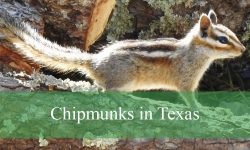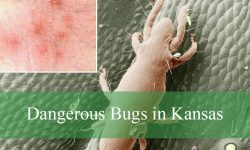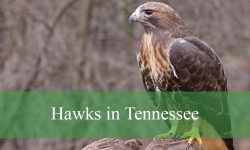Across California’s fields, gardens, and open landscapes, grasshoppers are among the most common insects. With their powerful hind legs and quick jumps, they are easily recognized and play an important role in local ecosystems. While some species are harmless, others can become agricultural pests, feeding on crops and grasses.
A wide range of grasshopper species inhabit California, each with unique colors, patterns, and behaviors. Some prefer dry grasslands, while others thrive in woodlands, deserts, or agricultural areas. Their adaptability makes them both fascinating to observe and challenging to manage for farmers and gardeners.
In this guide, you will find 15 types of grasshoppers in California, complete with pictures and identification tips. Learning their traits can help distinguish between species and better understand their role in the environment. This article provides all the details needed for nature enthusiasts or those encountering grasshoppers in backyards and farms.
Common Grasshoppers Found in California
Differential Grasshopper (Melanoplus differentialis)
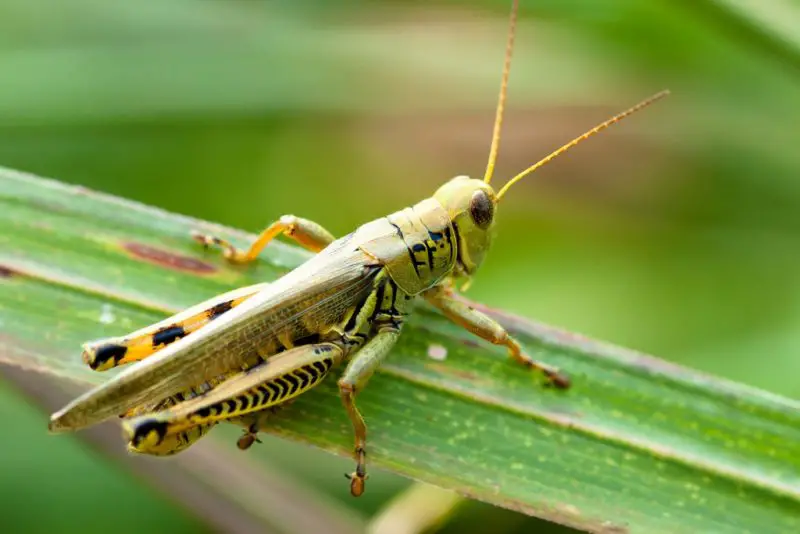
The Differential Grasshopper is one of the most recognizable species in California due to its relatively large size and distinctive coloration. Adults typically measure between 1.5 to 2 inches in length, with females being larger than males. Their bodies are usually olive green or yellowish, marked with dark chevron-shaped patterns along the hind femora. The hind legs are particularly robust, adapted for strong jumping, which is a primary means of escape when disturbed. The wings are fully developed, enabling them to fly moderate distances in search of food and suitable habitats.
Identification of this species is straightforward because of its black herringbone markings on the hind legs and the solid yellow underside. In California, it is most commonly seen in agricultural regions, especially during warm months when vegetation is abundant. Nymphs emerge in late spring and develop through several molts before reaching adulthood by midsummer. Their strong presence in open fields makes them both noticeable and impactful on surrounding ecosystems.
Behaviorally, Differential Grasshoppers are diurnal, most active during daylight hours when they bask in the sun to regulate their body temperature. They prefer open, sunny habitats such as grasslands, roadside vegetation, and croplands. Their feeding habits can make them a significant pest to farmers since they consume large amounts of broadleaf plants, grasses, and cultivated crops. They are opportunistic feeders, chewing on leaves and stems, sometimes stripping plants bare when populations are high.
In California, their distribution is widespread across agricultural valleys and open plains, especially in the Central Valley. They thrive in disturbed habitats where vegetation regrows quickly, providing consistent food sources. Because of their adaptability and broad diet, Differential Grasshoppers are considered one of the most economically important grasshopper pests in the state, capable of causing severe damage to alfalfa, corn, and vegetable crops during outbreak years.
Red-legged Grasshopper (Melanoplus femurrubrum)
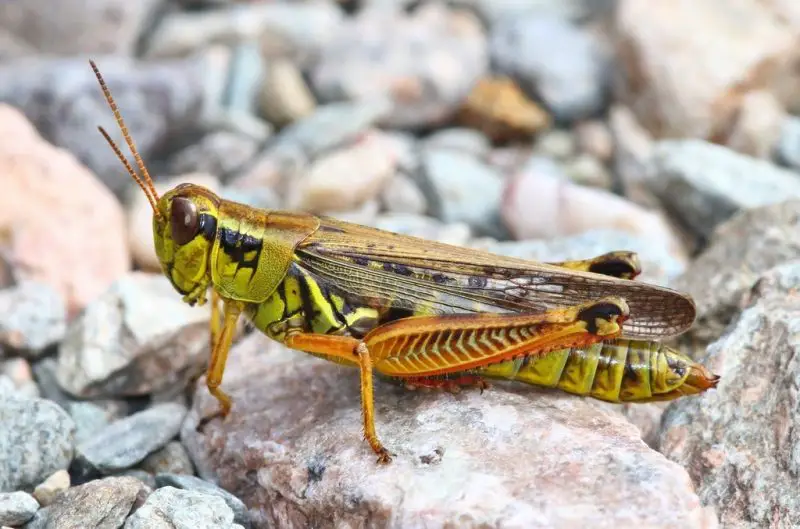
The Red-legged Grasshopper is smaller in size compared to some of its relatives, with adults ranging between 0.8 to 1.4 inches long. This species is easily recognized by its reddish hind femora, which contrast with its otherwise brown or greenish body. The wings are long and extend past the abdomen, allowing for flight, although they usually move by hopping. Their coloration helps them blend into grasses and soil, providing camouflage against predators such as birds and small mammals.
This grasshopper is widely distributed throughout California, often found in meadows, gardens, and agricultural fields. It tends to prefer areas with a mixture of grasses and broadleaf plants, which serve as both cover and food sources. Identification in the field is made easier by observing the red coloring on the hind legs and the yellowish underside. Juveniles resemble adults but are wingless and gradually develop adult coloration as they molt.
Behaviorally, the Red-legged Grasshopper is known for its adaptability and generalist feeding habits. It consumes a wide range of grasses and herbaceous plants, making it a common pest in gardens and farms. They are also highly mobile, frequently moving between patches of vegetation as food sources become scarce. Their feeding can weaken crops and reduce yields, especially in large populations. They are diurnal and often seen sunning themselves on vegetation in the morning to warm up before becoming more active.
In California, this species is abundant in both rural and suburban environments. They are especially common in the northern and central parts of the state, where pastures and croplands provide ideal conditions. While their feeding rarely causes as much damage as larger species like the Differential Grasshopper, they can still contribute to agricultural losses when numbers rise significantly. Their widespread distribution and resilience make them one of the most frequently encountered grasshoppers in the region.
Migratory Grasshopper (Melanoplus sanguinipes)
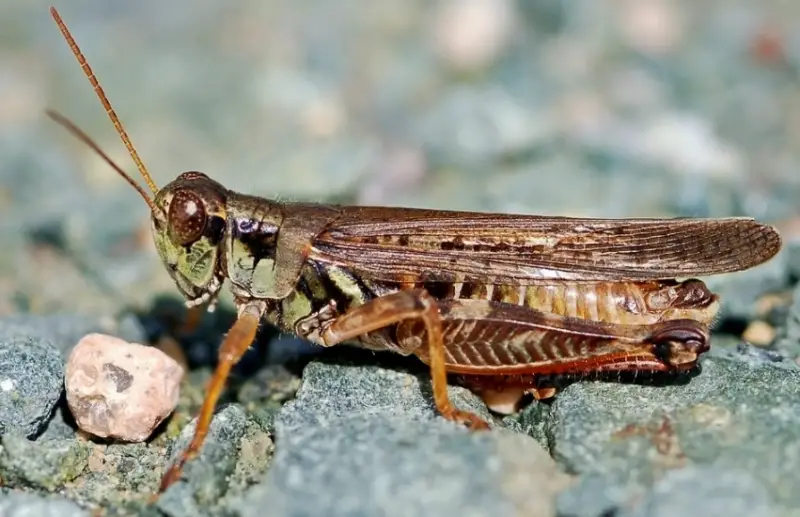
The Migratory Grasshopper is one of the most economically significant species across North America, and California is no exception. Adults range from 0.75 to 1.5 inches in length, with slender bodies that are typically grayish-brown or greenish, helping them blend into their surroundings. Their hind legs are well-developed for jumping, and their wings allow them to travel long distances, which is where they get their common name. Females are generally larger than males, a common trait among grasshoppers.
Identification of the Migratory Grasshopper involves looking at its relatively plain coloration, which often appears mottled or speckled, giving it excellent camouflage in dry grasslands and agricultural areas. Their hind femora are usually brown with faint markings, and the tibiae are often reddish. They are strong flyers, capable of covering vast areas in search of food, and this mobility allows them to expand their range quickly when conditions are favorable.
In terms of behavior, this species is particularly notorious for forming large aggregations during outbreak years. When populations peak, they can devastate crops, feeding on almost any available vegetation including cereals, grasses, alfalfa, and vegetables. They are primarily diurnal, spending mornings basking in the sun before becoming active feeders throughout the day. Their capacity for migration and swarming makes them one of the most challenging species for agricultural management.
In California, the Migratory Grasshopper is widely distributed in grasslands, open fields, and farming regions. They are especially common in the Central Valley and eastern parts of the state, where dry conditions favor their reproduction and survival. Because they thrive in disturbed habitats and can travel great distances, they pose a consistent threat to crops and rangelands, often requiring active monitoring and control measures during outbreak years.
Valley Grasshopper (Oedaleonotus enigma)

The Valley Grasshopper is a lesser-known but distinctive species found in California’s diverse landscapes. Adults are medium-sized, usually measuring around 1 inch in length, with coloration that varies from pale brown to gray. Their body patterns often include mottled markings that provide excellent camouflage against dry soils and grasses. Unlike some other species, their wings are often shorter, limiting their ability to fly long distances, making them more locally distributed.
Identification of the Valley Grasshopper can be challenging because its subtle coloration blends seamlessly with its environment. Its hind legs are strong for jumping, but the shorter wings are a useful distinguishing feature compared to more migratory species. Juveniles appear wingless and gradually develop coloration and partial wings as they molt. They are often overlooked due to their cryptic appearance, but careful observation reveals their unique adaptations to local habitats.
Behaviorally, Valley Grasshoppers are less aggressive feeders than some of the more notorious agricultural pests. They primarily consume grasses and herbaceous plants, often targeting native vegetation rather than cultivated crops. Their limited dispersal ability keeps their populations more localized, reducing the chance of widespread agricultural impact. They are diurnal, with activity levels peaking during warm daylight hours, particularly in sunny open areas.
In California, this species is most frequently found in lowland valleys, as its common name suggests. They prefer dry grasslands, foothills, and semi-arid habitats where vegetation is sparse. Their distribution tends to be patchy, often restricted to specific microhabitats where conditions suit their survival. While they may not pose as significant a threat to crops as other species, they remain an integral part of local ecosystems, contributing to the food web as prey for birds, reptiles, and mammals.
Two-striped Grasshopper (Melanoplus bivittatus)
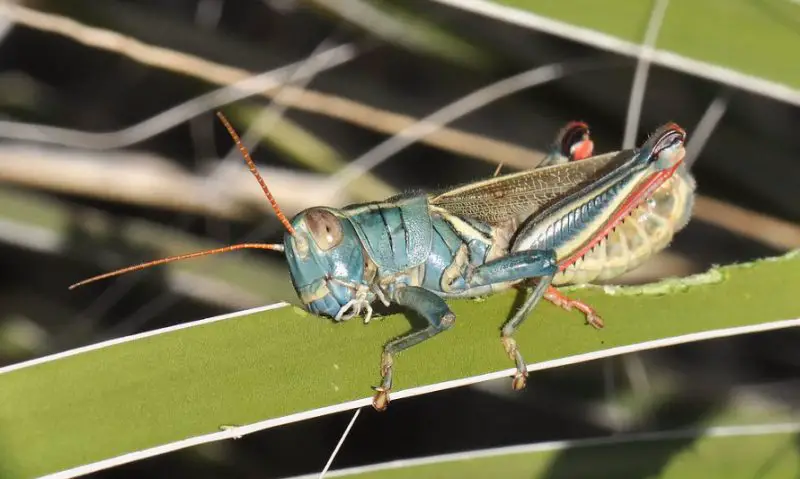
The Two-striped Grasshopper is a large and easily identifiable species that is common in California’s farmlands and grasslands. Adults measure between 1.5 to 2 inches long, with females being the larger sex. Their name comes from the two pale yellow stripes that run lengthwise from the head down to the tips of the wings, making them one of the most visually distinct grasshoppers in the state. Their hind femora are robust, marked with faint diagonal bands, and their wings are long, enabling flight over considerable distances.
This species is among the most destructive grasshoppers in North America due to its voracious feeding habits. It consumes a wide range of plants, including grasses, corn, alfalfa, wheat, and many garden crops. They often strip leaves and stems, sometimes leaving only the stalks behind when populations are high. Their generalist diet and ability to thrive in disturbed agricultural fields make them particularly problematic for farmers during outbreak years.
Behaviorally, the Two-striped Grasshopper is diurnal and highly active in warm, sunny conditions. They bask in the mornings before beginning their daily feeding activities. When disturbed, they either jump long distances or take to flight, covering large areas in search of food. They are also highly adaptable, capable of surviving in both natural grasslands and human-modified environments, which contributes to their success and wide distribution.
In California, the Two-striped Grasshopper is common across agricultural valleys, foothills, and grasslands. It is especially abundant in the Central Valley, where crops provide ample food sources. Because of its adaptability, strong flight, and broad diet, this species is often one of the first to cause visible damage to crops during grasshopper population surges. Its distinctive appearance makes it one of the easiest grasshoppers to recognize in the state, and also one of the most problematic for agriculture.
Pallid-winged Grasshopper (Trimerotropis pallidipennis)
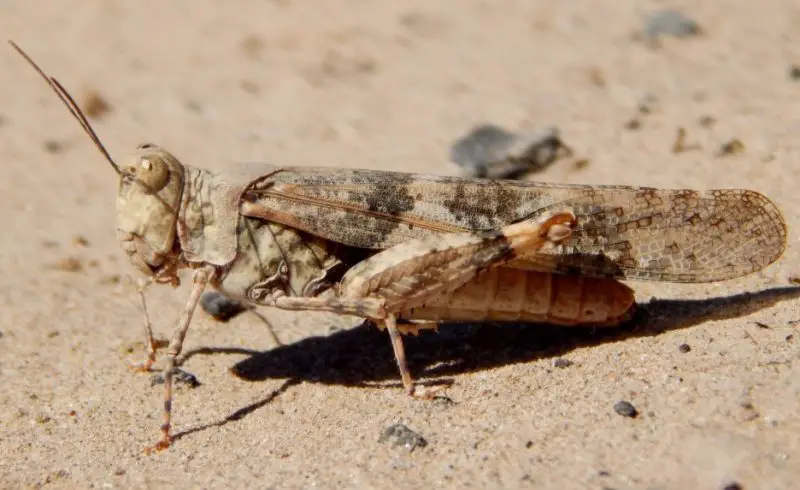
The Pallid-winged Grasshopper is a medium to large species that thrives in California’s arid and semi-arid landscapes. Adults typically measure 1 to 1.5 inches in length, with a body that is mottled gray or brown, allowing them to blend seamlessly into desert soils and rocky terrain. Their most distinctive feature is the pale, translucent wings that give them their common name, which flash in flight and help them avoid predators. The hind wings may also display a subtle yellowish tint when opened.
Identification of this species is aided by its cryptic coloration, which provides excellent camouflage against sandy or gravelly backgrounds. The forewings are usually speckled or streaked, helping them disappear when at rest. When flushed into flight, however, their pallid hind wings make them more noticeable, though they quickly settle back to the ground and vanish into their surroundings. Their bodies are slightly flattened, enhancing their ability to cling to dry soil and rock surfaces.
Behaviorally, Pallid-winged Grasshoppers are adapted to hot desert climates and are most active during the warmest parts of the day. They are strong fliers, capable of covering significant distances in search of vegetation. Their diet primarily consists of desert grasses and forbs, but they may also feed opportunistically on available shrubs when grasses are scarce. They play an important role in desert ecosystems, both as grazers and as prey for lizards, birds, and small mammals.
In California, their distribution is concentrated in the Mojave Desert, Colorado Desert, and other dry interior regions. They are particularly abundant in areas with sparse vegetation, where their camouflage provides protection and their flight ability allows them to move across open terrain. Their adaptability to desert conditions makes them one of the most successful grasshopper species in California’s driest habitats.
California Rose-winged Grasshopper (Schistocerca nitens)
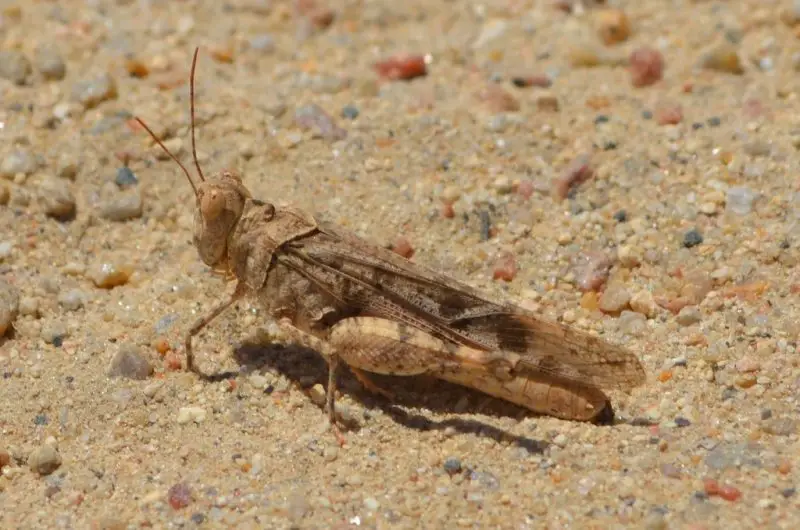
The California Rose-winged Grasshopper, also known as the Large Painted Grasshopper, is among the most striking grasshoppers in California. Adults can reach lengths of 2 to 3 inches, making them one of the larger species in the state. Their bodies are generally brownish or olive, but their hind wings are a vivid rose or pink color, revealed in flight and giving the species its common name. These bright wings are used both for display and as a defense mechanism to startle predators.
Identification is straightforward once the insect takes flight, as the vibrant rose-colored wings are unmistakable. At rest, however, their forewings are cryptically colored, blending in with grasses, shrubs, or bare soil. This dual adaptation of camouflage and warning display makes them highly successful in avoiding predation. Their large size also helps distinguish them from other grasshoppers commonly encountered in California’s fields and open spaces.
Behaviorally, the California Rose-winged Grasshopper is highly mobile and can fly long distances, sometimes even forming localized swarms under favorable conditions. They feed on a wide variety of plants, including agricultural crops, ornamental plants, and natural vegetation. Their feeding can be damaging when populations build up, especially in gardens and farmlands. These grasshoppers are diurnal, basking in the sun during the morning before beginning their active feeding and flying.
In California, this species is widespread, particularly in coastal regions, valleys, and foothills. It thrives in areas with diverse vegetation, including agricultural zones and suburban gardens. Because of its striking appearance and occasional pest status, the California Rose-winged Grasshopper is one of the most well-known species in the state, often noticed by residents when its rose-colored wings flash across fields and yards.
Creosote Bush Grasshopper (Bootettix argentatus)
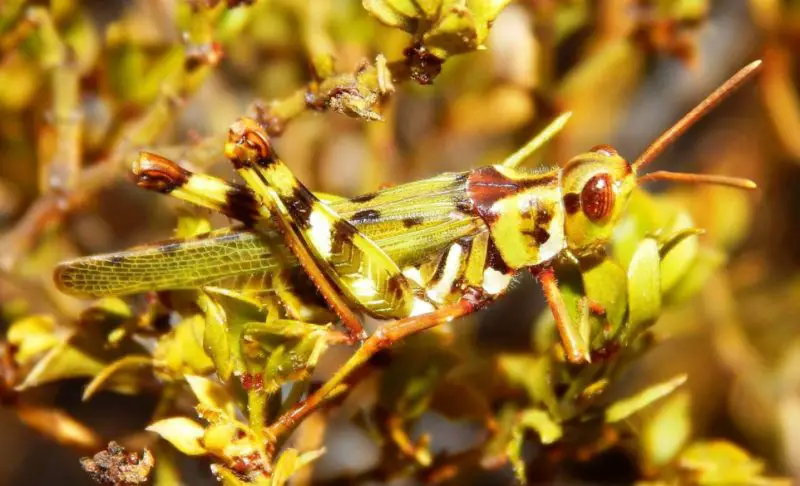
The Creosote Bush Grasshopper is a small but specialized species found in California’s desert regions. Adults typically measure less than 1 inch in length, with a slender body covered in fine silvery-gray scales that give them a shimmering appearance. This coloration allows them to blend almost perfectly with the leaves and stems of their preferred host plant, the creosote bush. Their wings are short compared to those of many other grasshoppers, limiting their ability to fly long distances.
Identification of this species is closely tied to its association with creosote bushes. They are almost always found within or near these shrubs, and their silvery body coloration makes them very difficult to spot unless they move. Unlike many other grasshoppers, they rarely venture away from their host plant, making habitat association a key factor in recognizing them. Their small size and narrow body further help them stay concealed within dense vegetation.
Behaviorally, Creosote Bush Grasshoppers are highly specialized feeders, relying almost exclusively on the creosote bush for both food and shelter. They are active during the day but tend to remain hidden among the plant’s branches, moving cautiously to avoid detection. Their limited diet and reliance on one plant species make them more vulnerable to environmental changes, yet they have evolved remarkable camouflage to survive in the harsh desert ecosystem.
In California, this species is found primarily in the Mojave and Colorado Deserts, where creosote bushes dominate the landscape. Their distribution is tightly linked to the range of this plant, which serves as their main habitat and food source. While they are not considered agricultural pests, they play an important ecological role in desert ecosystems, serving as both herbivores and prey for desert predators.
Speckle-winged Rangeland Grasshopper (Arphia conspersa)
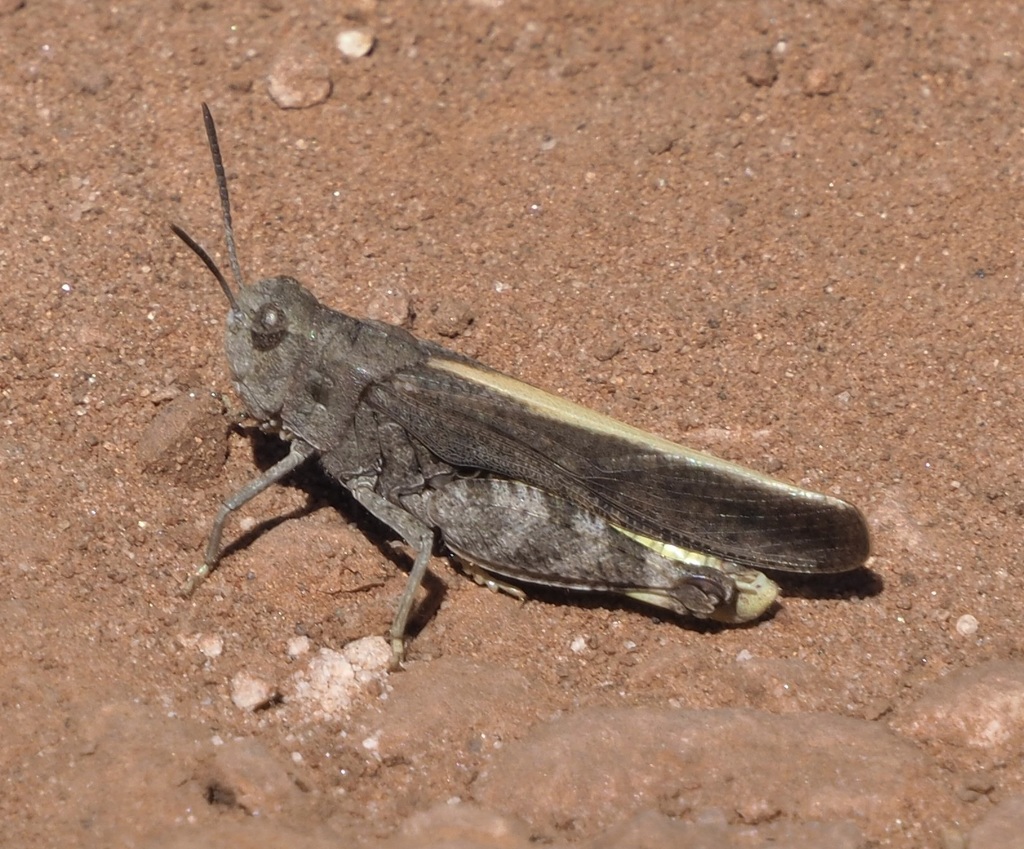
The Speckle-winged Rangeland Grasshopper is a medium-sized species known for its colorful and patterned hind wings. Adults typically measure between 1 and 1.5 inches long, with forewings that are mottled gray or brown, blending well with soil and grasses. When in flight, however, they display striking hind wings that are yellow, orange, or red with dark speckling, which helps deter predators. This flash of color is one of the species’ most distinctive traits.
Identification in the field is easiest when these grasshoppers take flight, as the speckled wings are highly visible. At rest, their cryptic forewings make them difficult to see against dry vegetation or bare ground. They are also strong fliers, often flying short distances when disturbed before dropping back to the ground and disappearing into the landscape. Their body is relatively stout, with strong hind legs that allow them to jump long distances.
Behaviorally, the Speckle-winged Rangeland Grasshopper is most active in sunny, open habitats such as grasslands, prairies, and rangelands. They are diurnal and spend much of their time basking and feeding. Their diet consists mainly of grasses, though they may also feed on other herbaceous plants. Populations can build up in rangelands, sometimes causing damage to forage plants that livestock depend on, making them of concern to ranchers.
In California, they are found throughout open rangelands, foothills, and dry grasslands, particularly in the central and eastern parts of the state. Their presence is often seasonal, with adults appearing in late spring and summer. The combination of camouflage at rest and striking wing coloration in flight makes them both difficult to spot and memorable once seen. They are an important part of California’s rangeland ecosystems, linking plant communities to higher predators.
Snakeweed Grasshopper (Hesperotettix viridis)
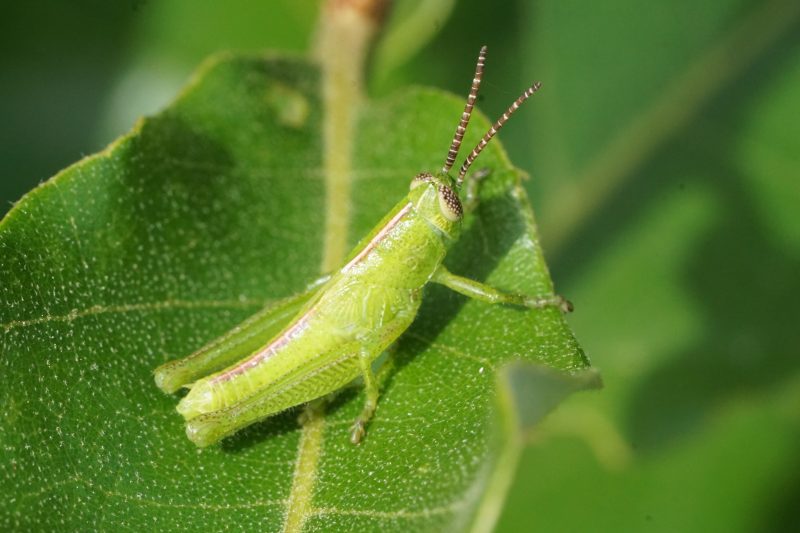
The Snakeweed Grasshopper is a medium-sized species, typically ranging from 0.8 to 1.2 inches in length, with a distinctive green body often marked with purple or pink highlights. Its coloration makes it one of the more colorful grasshoppers in California. The body is slender, and the hind legs are proportionately long, aiding in strong jumping ability. The wings are usually transparent or slightly tinted, extending to cover the abdomen.
Identification is facilitated by its association with snakeweed and other composite plants, which also influence its body coloration. Unlike many grasshoppers that appear drab, the Snakeweed Grasshopper often displays vivid hues that help it blend into the green and flowering parts of its host plants. Its bright colors make it relatively easy to recognize once seen, especially compared to the more muted grasshopper species that dominate California’s grasslands.
Behaviorally, this grasshopper is considered a specialist feeder, primarily consuming snakeweed and other related plants. While its feeding may affect localized plant populations, it is not regarded as a major agricultural pest due to its narrow diet. Snakeweed Grasshoppers are diurnal and spend much of their time perched on host plants, feeding and basking in the sun. Their colorful appearance likely serves as both camouflage and a warning signal to potential predators.
In California, they are most commonly found in rangelands, foothills, and semi-arid regions where snakeweed grows in abundance. Their distribution is patchy, as they are closely tied to the presence of suitable host plants. Although they do not pose a serious threat to crops, they contribute to the diversity of grasshopper species in the state and serve as prey for birds, reptiles, and small mammals that inhabit the same ecosystems.
Wrinkled Grasshopper (Hippiscus ocelote)
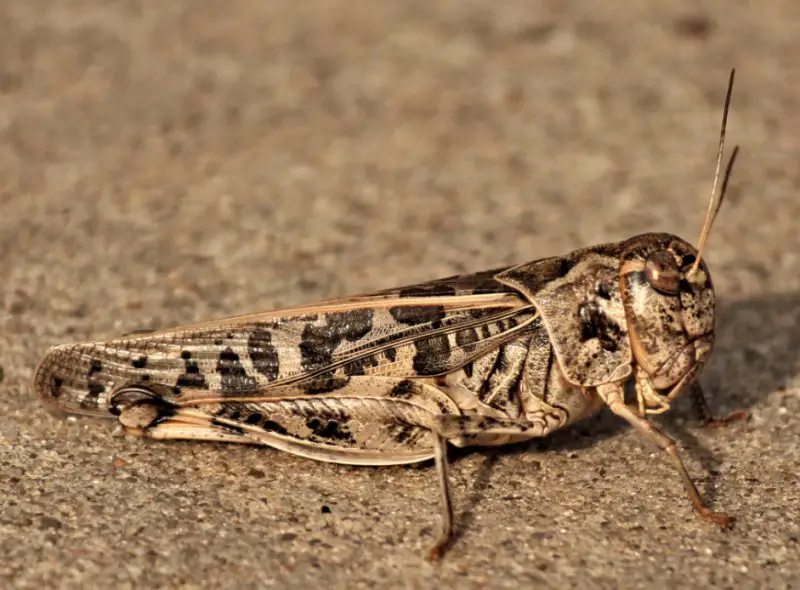
The Wrinkled Grasshopper is a large and powerful species that can grow up to 1.5 to 2 inches in length, making it one of the more noticeable grasshoppers in California. Its body is typically gray or brown with darker mottling, which provides camouflage against dry soil and rocky ground. The name “wrinkled” comes from the texture of its forewings, which appear rough or crinkled compared to the smoother wings of other species. Its hind wings are often brightly colored, flashing yellow or orange when in flight.
Identification of the Wrinkled Grasshopper is made easier by these distinctive hind wings, which are concealed at rest but highly visible in motion. The forewings blend perfectly into their surroundings, giving the insect an excellent disguise until disturbed. The species also has a robust build and strong hind legs, enabling long jumps and quick escapes from predators. Their large size makes them easier to spot than smaller, more cryptic grasshoppers.
Behaviorally, Wrinkled Grasshoppers are strong fliers and highly active during sunny, warm conditions. They are diurnal, spending mornings basking to raise their body temperature before becoming active feeders. Their diet consists of grasses and a variety of herbaceous plants, and when populations are high, they can strip vegetation in open habitats. Their bright hind wings serve both as a predator deterrent and as a startle display when they suddenly take off.
In California, they are most often found in open rangelands, dry grasslands, and foothill regions. They prefer sunny, sparsely vegetated areas where their camouflage is effective and their flight ability allows them to move easily between feeding sites. Though not always a major pest, Wrinkled Grasshoppers can cause localized damage to native vegetation and occasionally to crops when populations rise.
Flabellate Grasshopper (Circotettix rabula)
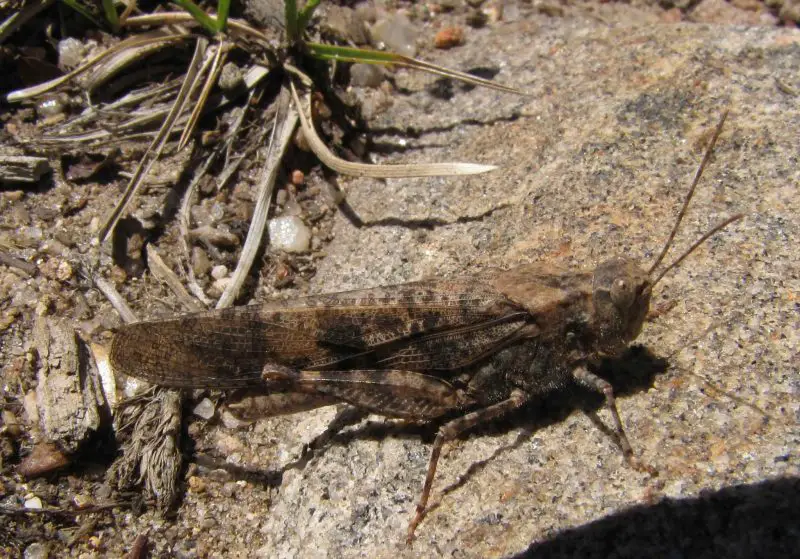
The Flabellate Grasshopper is a medium-sized species, averaging about 1 to 1.5 inches long, and is best known for its unique hind wings. While the forewings are mottled gray or brown and blend with soil or rocks, the hind wings are bright and fan-like, often yellow or orange with dark edging. This colorful flash during flight is one of its most distinguishing features and serves as a defense mechanism against predators.
Identification relies heavily on observing the insect in flight, as at rest the forewings conceal its vibrant hind wings. The forewings often appear speckled, giving the insect excellent camouflage in dry, open habitats. The species also produces a noticeable buzzing or crackling sound during flight, a form of stridulation that can help in identification. Its body is somewhat slender compared to bulkier grasshopper species, giving it an agile appearance.
Behaviorally, Flabellate Grasshoppers are highly active and strong fliers, often taking off with a loud, rattling sound when disturbed. They feed primarily on grasses and a variety of herbaceous plants, making them common in grasslands, foothills, and open rangelands. Their bright wings and buzzing flight not only serve as a predator deterrent but also play a role in courtship displays, as males use sound and visual cues to attract mates.
In California, they are distributed across dry open areas, particularly in the foothills, deserts, and rangelands. They thrive in environments where grasses dominate, and their loud flight displays are a common sight in late spring and summer. Although not considered a major pest, they play an important role in grassland ecosystems as both herbivores and prey.
Bunchgrass Grasshopper (Ageneotettix deorum)

The Bunchgrass Grasshopper is a small to medium-sized species, usually around 0.6 to 1 inch long, with a body that is typically brown or gray, often streaked with lighter markings. Its coloration provides excellent camouflage in dry bunchgrass prairies, where it is most commonly found. Unlike more colorful species, its wings are relatively plain, with forewings that extend nearly to the tip of the abdomen and hind wings that are clear or faintly tinted.
Identification of the Bunchgrass Grasshopper is aided by its habitat association, as it is strongly tied to native bunchgrass prairies and open rangelands. Its relatively small size and subtle coloration can make it difficult to notice until it moves. Nymphs are similarly cryptic, resembling tiny versions of the adults with wing buds that gradually lengthen with successive molts.
Behaviorally, the Bunchgrass Grasshopper is highly specialized, feeding mainly on native grasses rather than a broad range of plants. This makes it less of an agricultural pest compared to more generalist species. It is diurnal, active during the heat of the day, and spends much of its time hopping between clumps of grasses, where it feeds and shelters from predators. Its restricted diet reflects its adaptation to grassland habitats, where it thrives in stable plant communities.
In California, this species is found in grassland ecosystems, particularly in foothills and rangelands where native bunchgrasses remain abundant. It is less common in highly disturbed agricultural lands, preferring areas with natural vegetation. Its ecological role is important, as it contributes to the balance of grassland plant communities while serving as a food source for birds and other grasshopper predators.
Stripe-winged Grasshopper (Trimerotropis spars)

The Stripe-winged Grasshopper is a medium-sized species that measures about 1 to 1.5 inches long, with forewings that are mottled gray, brown, or tan. As its name suggests, the hind wings often have distinctive dark stripes across them, revealed only in flight. This striking pattern contrasts with its otherwise cryptic appearance and serves to startle predators when the insect suddenly takes off.
Identification is easiest when the grasshopper is disturbed and flies short distances, displaying its banded hind wings. At rest, the forewings provide superb camouflage against bare soil, gravel, or rocky terrain. Its body is relatively stout, and the strong hind legs are adapted for both jumping and producing loud snapping or crackling sounds during flight, another characteristic of this species.
Behaviorally, the Stripe-winged Grasshopper is diurnal and most active in hot, open environments. It feeds mainly on grasses and occasionally on forbs, making it a common inhabitant of rangelands, deserts, and dry foothills. When flushed, they often fly with a noticeable crackling sound, which is both a defense mechanism and part of mating behavior. They are strong fliers, capable of moving across large open areas in search of vegetation.
In California, they are commonly distributed across dry rangelands, rocky hillsides, and desert basins. Their striking wing patterns and audible flight displays make them one of the more recognizable band-winged grasshoppers in the state. While they may occasionally feed on forage grasses, they are not typically regarded as serious agricultural pests, instead playing a role in maintaining the natural balance of grassland ecosystems.
Red-shanked Grasshopper (Xanthippus corallipes)
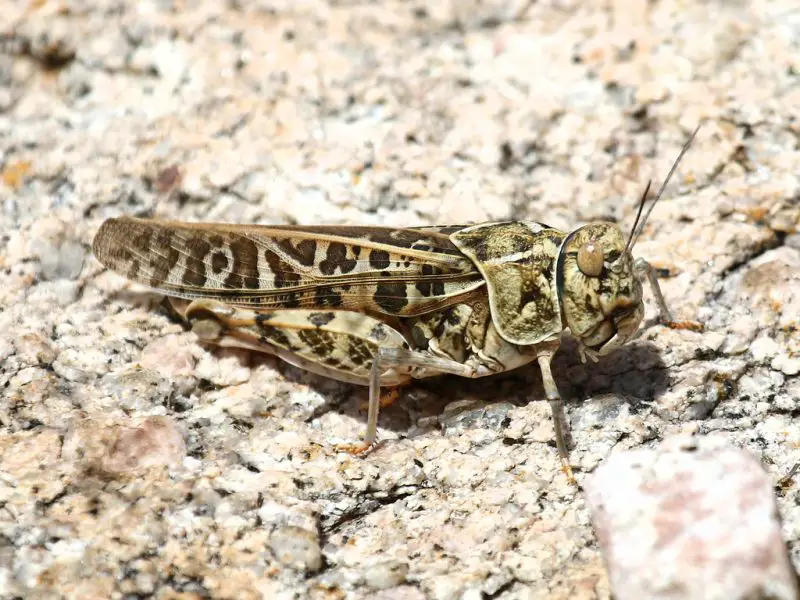
The Red-shanked Grasshopper is a large and robust species, often reaching lengths of 1.5 to 2 inches, with a striking appearance that makes it one of the more easily identified grasshoppers in California. Its body is generally brown or gray with mottled patterns for camouflage, but the hind legs are vividly marked with red or coral coloration, giving the species its common name. The hind wings are also brightly colored, often displaying yellow or orange with dark borders.
Identification is straightforward due to the combination of bright red hind legs and colorful wings, which contrast sharply with its otherwise camouflaged body. At rest, it blends seamlessly into rocky soils and grasslands, but when in motion, the sudden flash of red and yellow makes it stand out dramatically. Its size, coloration, and powerful legs make it one of the more conspicuous species in the state’s open landscapes.
Behaviorally, Red-shanked Grasshoppers are strong fliers and are often flushed into the air when disturbed, showing off their vivid wings. They are diurnal, basking in the sun to warm themselves before feeding actively during the day. Their diet is varied, consisting mainly of grasses but also including other herbaceous plants when available. In high densities, they may cause damage to forage plants and rangelands, making them a species of interest in agricultural contexts.
In California, this grasshopper is commonly found in open rangelands, foothills, and dry grasslands. They are particularly abundant in the Great Basin region and other semi-arid environments where their preferred grasses are plentiful. Their striking coloration makes them memorable to observers, and they are an important part of the food chain, providing prey for raptors, reptiles, and small mammals.
FAQs about Grasshoppers in California
What are the most common grasshoppers found in California?
California is home to a wide variety of grasshoppers, with some of the most common species including the Differential Grasshopper, Red-legged Grasshopper, Migratory Grasshopper, Two-striped Grasshopper, and Pallid-winged Grasshopper. These species are frequently observed in agricultural valleys, grasslands, and foothills across the state.
How can I identify different grasshopper species in California?
Identification often depends on size, coloration, wing markings, and habitat preferences. For example, the Differential Grasshopper has chevron-shaped markings on its hind legs, the Red-legged Grasshopper has reddish hind femora, while the California Rose-winged Grasshopper reveals vivid pink wings in flight. Observing both resting camouflage and flight displays is key to accurate identification.
Do grasshoppers in California cause crop damage?
Yes, several species are considered agricultural pests, particularly the Differential Grasshopper, Two-striped Grasshopper, and Migratory Grasshopper. These species consume large amounts of vegetation and can damage crops such as alfalfa, corn, wheat, and vegetables. Outbreaks can lead to significant losses in farming areas, especially in the Central Valley.
What do grasshoppers in California eat?
Most grasshoppers are herbivores that feed primarily on grasses and broadleaf plants. Generalist feeders like the Two-striped Grasshopper consume a wide range of crops, while specialist species such as the Creosote Bush Grasshopper feed almost exclusively on a single plant. Their diets vary depending on species and available vegetation.
Where are grasshoppers most commonly found in California?
Grasshoppers can be found throughout the state, from coastal valleys to desert basins. The Central Valley supports large populations due to its abundance of crops, while desert species like the Pallid-winged Grasshopper and Creosote Bush Grasshopper thrive in arid environments. Foothills and rangelands also host many species adapted to dry grasslands.
Are grasshoppers dangerous to humans?
No, grasshoppers are not dangerous to humans. They do not bite or sting, and they do not carry diseases that affect people. Their main impact is ecological and agricultural, as they play a role in food webs but can also cause crop damage during population outbreaks.
Why do some grasshoppers in California have brightly colored wings?
Brightly colored hind wings serve as a defense mechanism. Species such as the California Rose-winged Grasshopper and the Red-shanked Grasshopper use sudden flashes of color to startle predators during flight. These displays can also play a role in courtship and communication between individuals.
What role do grasshoppers play in California ecosystems?
Grasshoppers are important herbivores that help regulate plant communities, recycling nutrients back into the soil. They also serve as a vital food source for birds, reptiles, mammals, and insects. Even species that are occasional pests contribute to maintaining ecological balance in their natural habitats.

